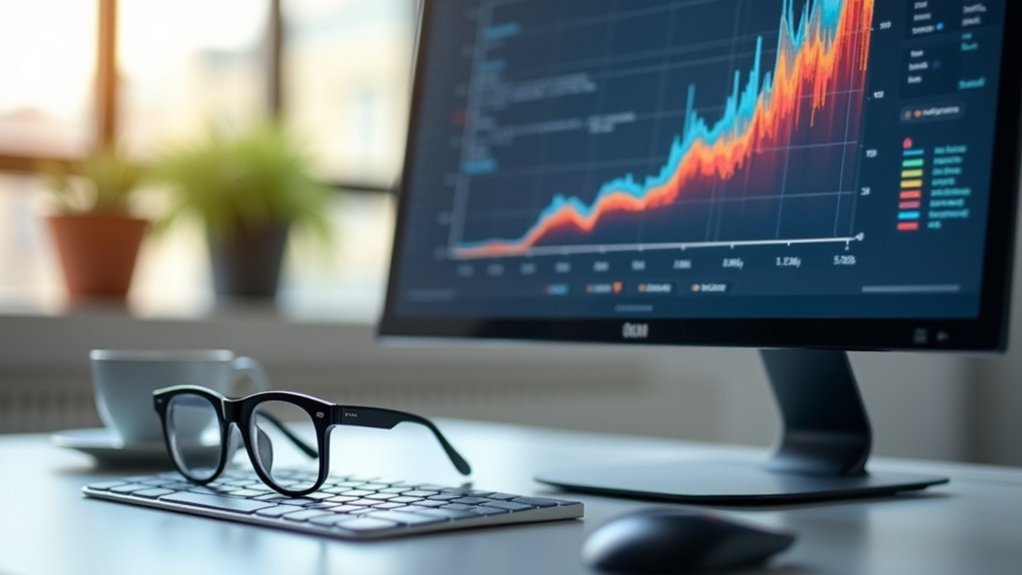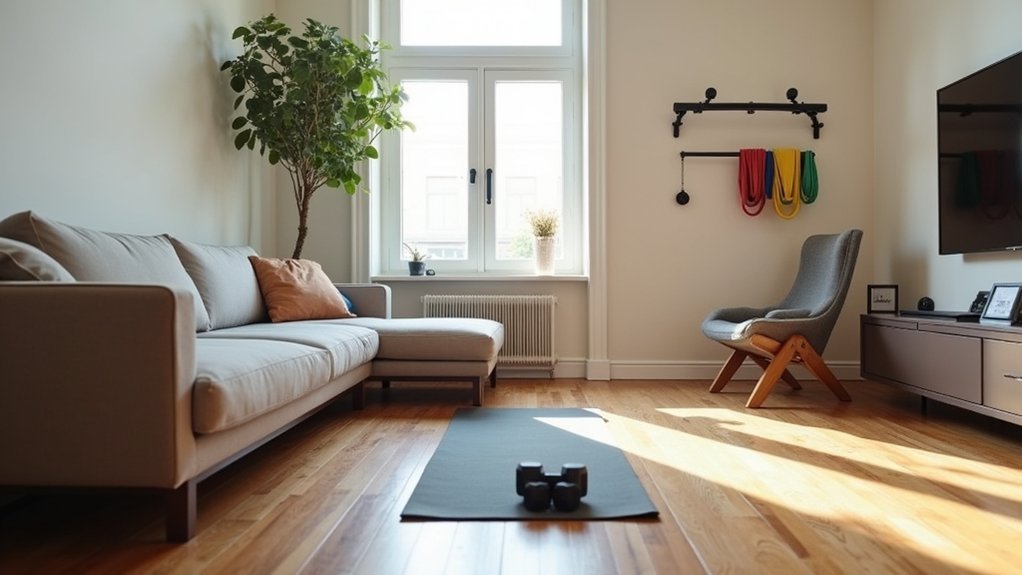You can dramatically reduce eye tracking delay by optimizing your hardware with high CPU/GPU specs and 120Hz+ monitors, calibrating systems properly with cameras positioned near display bottoms, controlling environmental lighting to eliminate glare, updating software and firmware regularly, fine-tuning sampling rates and data processing settings, minimizing head movement while maintaining proper positioning within 35-degree gaze angles, and implementing predictive algorithms with motion compensation techniques. These thorough strategies will transform your tracking performance and accuracy.
Optimize Hardware Specifications and Processing Power
When you’re building an eye tracking system, your hardware specifications directly impact tracking delay and overall performance.
You’ll need a computer with substantial processing power, as increased CPU and GPU capabilities enhance your tracking algorithms’ speed and accuracy.
Select a monitor with at least 120Hz refresh rate to provide smoother visual output and reduce response delays.
Your camera choice matters considerably.
Opt for high resolution equipment (minimum 720p) with fast shutter speeds to capture quick eye movements without lag.
Position the camera closer to participants’ eyes to minimize latency effectively.
Implement low-latency communication protocols between your tracking device and processing unit.
Establishing efficient data pathways between your eye tracker and computer ensures millisecond-precise transmission for optimal real-time performance.
This guarantees real-time data transmission flows seamlessly, markedly reducing tracking delays and improving your system’s responsiveness.
Calibrate Eye Tracking Systems for Maximum Accuracy
Proper calibration serves as the foundation for accurate eye tracking measurements and greatly reduces delay-causing errors.
When you calibrate eye tracking systems, position your camera and infrared lamp near the display’s bottom to optimize corneal reflection and minimize interference. Adjust your camera aperture to increase depth of field, ensuring both eyes stay focused simultaneously.
You’ll reduce tracking discrepancies by removing reflective surfaces like glasses or jewelry that create problematic glare.
During longer studies, recalibrate regularly to counteract drift from subtle position shifts that degrade tracking quality over time.
Most importantly, maintain proper gaze angle by keeping participants’ viewing angles within 35 degrees. This prevents tracking issues associated with eccentric gaze positions, ensuring your system captures precise eye movements without delay-inducing errors.
Reduce Environmental Interference and Lighting Issues

Environmental factors can sabotage even the most precisely calibrated eye tracking system. To reduce environmental interference, you’ll need to control your surroundings carefully.
Start with consistent lighting that eliminates harsh shadows and glare, which disrupt accurate eye movement detection. Avoid glossy surfaces for reading materials since reflections scatter light unpredictably.
Position your screen or materials at ideal distance and angle to enhance visual clarity. Background distractions like conversations, movement, or flickering lights can throw off your tracking accuracy, so minimize these interruptions.
Consider using colored overlays or filters to reduce visual stress and improve contrast. These environmental adjustments create stable conditions that allow your eye tracking technology to perform at peak efficiency, reducing delays and improving overall system responsiveness.
Update Eye Tracking Software and Firmware Regularly
You’ll want to regularly check for software updates from your eye tracking manufacturer, as these releases often contain critical performance improvements and bug fixes that directly reduce tracking delays.
Installing the latest firmware guarantees your hardware operates with peak efficiency and maintains compatibility with newer system components.
Don’t forget to review and enhance your performance settings after each update, as new configuration options can further improve tracking responsiveness.
Check for Updates
One of the most overlooked yet effective ways to reduce eye tracking delay involves keeping your software and firmware current.
You’ll notice significant improvements in your eye tracking skills when you regularly check for available updates. Most systems automatically notify you when new versions are released, making the process straightforward.
These updates often contain critical patches that address tracking disorder issues and enhance overall performance.
You’ll experience more accurate eye movement detection and reduced response times after installing the latest versions. Updated algorithms provide improved tracking capabilities, guaranteeing smoother calibration and better data quality.
Don’t ignore those update notifications – they’re essential for maintaining peak performance.
Check your system settings regularly to verify automatic updates are enabled for seamless accurate eye tracking performance.
Install Latest Firmware
Installing the latest firmware represents a critical step in maintaining your eye tracking system’s peak performance. When you install the latest firmware, you’re accessing enhancements that directly improve accuracy and responsiveness in eye tracking technology.
These updates specifically target issues that cause tracking delays, ensuring smoother operation. Manufacturers regularly release firmware updates to address compatibility problems with new devices and operating systems.
You’ll miss out on advanced features and enhancements if you don’t update regularly. New firmware versions improve the calibration process, enabling more precise tracking that minimizes delays during use.
Don’t let outdated firmware compromise your system’s potential. Regular updates fix bugs contributing to lag and deliver superior performance improvements that keep your eye tracking technology running efficiently.
Optimize Performance Settings
Beyond firmware updates, optimizing your eye tracking software’s performance settings can dramatically reduce response delays and enhance tracking precision.
You’ll want to regularly check for software updates that include performance enhancements specifically targeting eye tracking problems. These updates often contain bug fixes and algorithm optimizations that improve eye tracking responsiveness and accuracy.
Adjust your software’s sampling rate settings to match your hardware capabilities, as higher frequencies can reduce latency.
Configure smoothing parameters to balance precision with stability, and disable unnecessary background processes that might interfere with tracking.
Enable hardware acceleration features when available, as they offload processing tasks from your CPU to dedicated components.
To improve eye tracking consistently, establish a routine for checking manufacturer websites for the latest performance patches and configuration recommendations.
Adjust Sampling Rates and Data Processing Settings
You can greatly reduce eye tracking delay by fine-tuning your system’s sampling rates and data processing parameters.
Start by optimizing your sampling frequency to match your specific application needs—higher frequencies aren’t always better if they create unnecessary computational overhead.
Focus on reducing processing burden and streamlining your data buffering methods to guarantee smooth, real-time eye movement capture without bottlenecks.
Optimize Sampling Frequency
Most eye tracking systems can dramatically reduce latency by adjusting their sampling frequency and streamlining data processing workflows.
You’ll find that higher sampling rates capture more detailed eye movement data, particularly during rapid saccades and smooth pursuits. This enhanced data collection directly improves your tracking performance by providing richer information about eye behaviors.
You should tune your data processing settings to minimize delays between capture and output, ensuring real-time feedback delivery.
Reducing processing overhead helps maintain higher frame rates, which is essential for tracking fast movements without information loss.
By implementing efficient algorithms, you’ll streamline eye movement data handling, effectively decreasing latency while boosting overall responsiveness.
These optimizations create a more responsive tracking system.
Reduce Processing Overhead
When processing overhead becomes a bottleneck, strategic adjustments to your sampling rates and data processing settings can release considerable performance gains.
You’ll achieve faster eye tracking by reducing your device’s sampling frequency to match your application’s requirements. Lower sampling rates mean less data to process, directly decreasing computational burden and response delays.
Streamline your data processing by limiting simultaneous tracking points and reducing resolution when high precision isn’t critical. These adjustments minimize the information your system must analyze, accelerating processing speeds considerably.
Implement optimized algorithms specifically designed for efficient eye movement analysis. These specialized processing methods handle data more effectively than generic approaches.
Consider upgrading to hardware with enhanced processing capabilities if software optimizations aren’t sufficient. Faster processors dramatically reduce analysis time, improving overall tracking performance and user experience.
Streamline Data Buffering
Buffer management systems control how your eye tracking device stores and processes incoming data streams. You can markedly reduce delays by implementing smart buffering strategies that prioritize essential eye movements data over less critical information.
Configure your buffer management to process the most recent eye tracking data first, discarding older data points that aren’t immediately relevant to your application.
Optimize your processing speed by adjusting buffer sizes to match your system’s capabilities. Smaller buffers require less memory but need faster processing, while larger buffers can accumulate delays.
Apply data compression techniques to reduce the volume of information flowing through your buffers. This approach minimizes bandwidth requirements and accelerates data transmission, resulting in more responsive eye tracking performance for real-time applications.
Minimize Head Movement and Maintain Proper Positioning
Although eye tracking relies primarily on ocular muscles, excessive head movement can considerably disrupt your visual processing and create unnecessary delays.
To minimize head movement during visual tracking tasks, maintain a stable, upright posture with your head aligned to the text or focus object.
Position reading materials at eye level, typically 14-18 inches away, eliminating the need for excessive tilting. Use a document holder or reading stand to keep materials steady and properly aligned with your eyes. This proper positioning promotes smoother tracking while reducing head shifts.
Guide your eyes with a finger or pointer along text lines to minimize losing your place.
Regularly practice eye exercises that enhance coordination between eye movements and head positioning, ultimately improving your tracking abilities and reducing delays.
Implement Predictive Algorithms and Motion Compensation
Since modern eye tracking systems process thousands of data points per second, implementing predictive algorithms becomes essential for reducing lag and improving your overall experience. These algorithms anticipate your eye movements based on previous tracking patterns, enabling smoother shifts and minimal perceived delays.
Motion compensation techniques work alongside predictive algorithms to adjust for head movements and other factors that could compromise tracking accuracy. By incorporating Kalman filters, you’ll minimize noise and uncertainty in tracking data while maintaining precise eye position estimates.
Real-time data processing capabilities allow your system to quickly adapt to changing eye movements, markedly decreasing lag in gaming and virtual reality applications.
When you combine predictive algorithms with advanced machine learning models, the system continuously improves tracking accuracy by learning from your unique behavioral patterns over time.
Frequently Asked Questions
How Can I Improve My Eye Tracking Speed?
You can improve eye tracking speed through vision therapy exercises, using reading apps with word highlighting, playing sports like ping pong, employing finger-guided reading techniques, and practicing with colored overlays or tracking games.
What Causes Slow Eye Tracking?
Your slow eye tracking stems from oculomotor dysfunction, neurological issues, ADHD, visual processing disorders like dyslexia, or environmental factors including excessive screen time and poor lighting that strain your eye muscles.
Why Are My Eyes Having a Hard Time Tracking?
You’re experiencing eye tracking difficulties because your eye movement skills may be underdeveloped, affecting smooth pursuits and saccades. This could stem from oculomotor dysfunction, dyslexia-related deficits, or ADHD-linked involuntary movements.
How Can I Improve My Baby’s Eye Tracking?
You can improve your baby’s eye tracking by moving colorful toys slowly across their sight, using high-contrast images, encouraging reaching for moving objects, limiting screen time, and consulting a pediatric optometrist if needed.
In Summary
You’ve got the tools to drastically reduce eye tracking delay. Start by upgrading your hardware and calibrating your system properly. Don’t overlook environmental factors like lighting, and keep your software updated. Fine-tune those sampling rates, maintain steady positioning, and implement predictive algorithms. You’ll notice immediate improvements in responsiveness and accuracy. Apply these seven strategies consistently, and you’ll achieve the smooth, real-time eye tracking performance you’re aiming for.





Leave a Reply